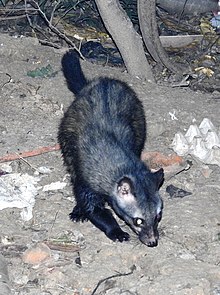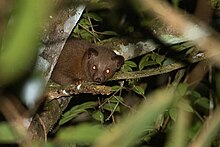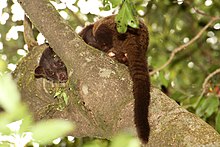Палмови цивети
 Тази статия е за подсемейството коткоподобни. За рода вижте Палмови цивети (род).
Тази статия е за подсемейството коткоподобни. За рода вижте Палмови цивети (род).
| Палмови цивети | ||||||||||||||||||||||||||||||||||||
 Бинтуронг (A. binturong) | ||||||||||||||||||||||||||||||||||||
| Класификация | ||||||||||||||||||||||||||||||||||||
| ||||||||||||||||||||||||||||||||||||
| Научно наименование | ||||||||||||||||||||||||||||||||||||
Gray, 1864 | ||||||||||||||||||||||||||||||||||||
| Палмови цивети в Общомедия | ||||||||||||||||||||||||||||||||||||
| [ редактиране ] |
Палмови цивети (Paradoxurinae) е подсемейство на Коткоподобни Виверови, което е наименовано и описано за първи път от Джон Едуард Грей през 1864 г.[1] Поукък включва в това подсемейство родовете Paradoxurus, Paguma и Arctictis.[2][3]
Класификация
Живи видове
| Род | Видове | Статус и разпространение в |
|---|---|---|
| Paradoxurus Cuvier, 1822[4] | Азиатска палмова цивета | LC 
|
| Златна палмова цивета
(P. zeylonensis) (Pallas, 1778)[6] |
VU 
| |
| Южноиндийски мусанг
(P. jerdoni) Blanford, 1885[7] |
LC 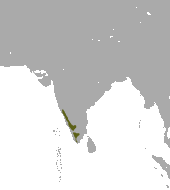
| |
| Arctictis Temminck, 1824[8] | Бинтуронг ( A. binturong ) (Raffles, 1822)[9]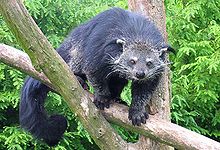
|
VU 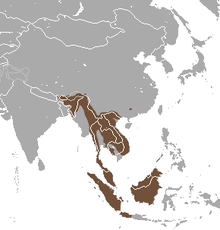
|
| Paguma Gray, 1831[10] | Хималайска цивета
(P. larvata) (Smith, 1827)[11] |
LC 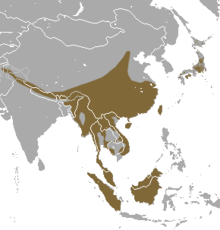
|
| Arctogalidia Merriam, 1897[12] | Дребнозъба цивета
(A. trivirgata) (Gray, 1832)[13] |
LC 
|
Изчезнали родове
- Kichechia Savage, 1965[14][15]
- Tugenictis Morales & Pickford, 2005[16][17]
- Kanuites Dehghani & Werdelin, 2008[18][17]
- Siamictis Grohé et al., 2020[19]
Източници
- ↑ Gray, J. E. A revision of the genera and species of viverrine animals (Viverridae), founded on the collection in the British Museum // Proceedings of the Zoological Society of London for the Year 1864. 1864. с. 502–579.
- ↑ Pocock, R. I. The rarer genera of oriental Viverridae // Proceedings of the Zoological Society of London 103 (4). 1933. DOI:10.1111/j.1096-3642.1933.tb01638.x. с. 969–1035.
- ↑ Pocock, R. I. Paradoxurinae // The Fauna of British India, including Ceylon and Burma. Т. ((Mammalia. Volume 1)). London, Taylor and Francis, 1939. с. 376–439.
- ↑ Cuvier, F. Du genre Paradoxure et de deux espèces nouvelles qui s’y rapportent // Mémoires du Muséum d'Histoire Naturelle. Т. 9. Paris, A. Belin, 1822. с. 41–48.
- ↑ Pallas, P. S. Das Zwitterstinktier Viverra hermaphrodita // Die Säugethiere in Abbildungen nach der Natur, mit Beschreibungen. Erlangen, Wolfgang Walther, 1778. с. 426.
- ↑ Pallas, P. S. Der Boshond Viverra zeylonensis // Die Säugethiere in Abbildungen nach der Natur, mit Beschreibungen. Erlangen, Wolfgang Walther, 1778. с. 451–452.
- ↑ Blanford, W.T. Exhibition and description of a skull of an apparently new Species of Paradoxurus (Paradoxurus jerdoni) // Proceedings of the Zoological Society of London. 1855. с. 612–613.
- ↑ Temminck, C. J. XVII Genre Arctictis // Monographies de mammalogie. Paris, Dufour & d'Ocagne, 1824. с. xxi.
- ↑ Raffles, T. S. XVII. Descriptive Catalogue of a Zoological Collection, made on account of the Honourable East India Company, in the Island of Sumatra and its Vicinity, under the Direction of Sir Thomas Stamford Raffles, Lieutenant-Governor of Fort Marlborough', with additional Notices illustrative of the Natural History of those Countries // The Transactions of the Linnean Society of London XIII. 1822. с. 239–274.
- ↑ Gray, J. E. Paguma // Proceedings of the Committee of Science and Correspondence of the Zoological Society of London. Т. 1. London, Zoological Society of London, 1831. с. 95.
- ↑ Smith, C.H. Gulo larvatus, the Masked Glutton // The animal kingdom : arranged in conformity with its organization. Т. 2. Mammalia. London, G.B. Whittaker, 1827. с. 281.
- ↑ Merriam, C. H. The generic names Ictis, Arctogale, and Arctogalidia // Science 5 (112). 1897. DOI:10.1126/science.5.112.302. с. 302.
- ↑ Gray, J. E. On the family of Viverridae and its generic sub-divisions, with an enumeration of the species of several new ones // Proceedings of the Committee of Science and Correspondence of the Zoological Society of London 2. 1832. с. 63–68.
- ↑ Savage, R. J. G. Fossil mammals of Africa: 19, The Miocene Carnivora of East Africa // Bulletin of the British Museum (Natural History) 10 (8). 1965. с. 239–316.
- ↑ Adrian, B. и др. New Miocene Carnivora (Mammalia) from Moruorot and Kalodirr, Kenya // Palaeontologia Electronica 21 (1 10A). 2018. DOI:10.26879/778. с. 1–19.
- ↑ Morales, J. и др. Carnivores from the Middle Miocene Ngorora Formation (13-12 Ma), Kenya // Estudios Geológicos 61 (3–6). 2005. DOI:10.3989/egeol.05613-668. с. 271–284.
- ↑ а б Werdelin, L. Middle Miocene Carnivora and Hyaenodonta from Fort Ternan, western Kenya // Geodiversitas 41 (6). 2019. DOI:10.5252/geodiversitas2019v41a6. с. 267.
- ↑ Dehghani, R. и др. A new small carnivoran from the Middle Miocene of Fort Ternan, Kenya // Neues Jahrbuch für Geologie und Paläontologie - Abhandlungen 248 (2). 2008. DOI:10.1127/0077-7749/2008/0248-0233. с. 233–244.
- ↑ Grohé, C. и др. The Late Middle Miocene Mae Moh Basin of Northern Thailand: The Richest Neogene Assemblage of Carnivora from Southeast Asia and a Paleobiogeographic Analysis of Miocene Asian Carnivorans // American Museum Novitates (3952). 2020. DOI:10.1206/3952.1. с. 1–57.
|
| Тази страница частично или изцяло представлява превод на страницата Paradoxurinae в Уикипедия на английски. Оригиналният текст, както и този превод, са защитени от Лиценза „Криейтив Комънс – Признание – Споделяне на споделеното“, а за съдържание, създадено преди юни 2009 година – от Лиценза за свободна документация на ГНУ. Прегледайте историята на редакциите на оригиналната страница, както и на преводната страница, за да видите списъка на съавторите.
ВАЖНО: Този шаблон се отнася единствено до авторските права върху съдържанието на статията. Добавянето му не отменя изискването да се посочват конкретни източници на твърденията, които да бъдат благонадеждни. |
